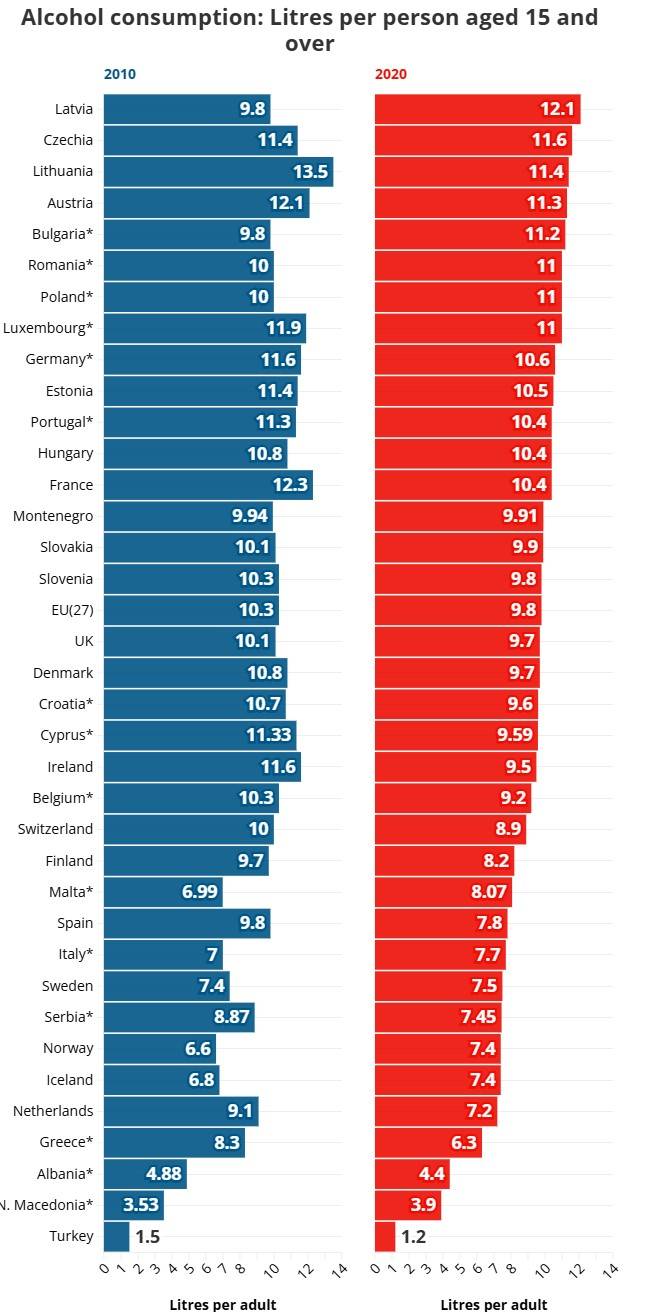Europe's heaviest drinkers: Which country tops the list?
A close look at the regions with the highest alcohol consumption
2025-04-08

Latvia has emerged as the country with the highest alcohol consumption in Europe, according to data from 2020. Among 36 European countries, including EU member states, the UK, EFTA countries and EU candidates, Latvia recorded an average of 12.1 liters of pure alcohol consumed per person aged 15 and over. This figure places it at the top of the list, ahead of other high-consuming nations such as Czechia and Lithuania.
The data, compiled by the World Health Organization (WHO) and other European health agencies, shows that while overall alcohol consumption in Europe has declined over the past four decades, some countries have seen increases. Between 1980 and 2020, average alcohol consumption in the EU dropped from 12.7 liters to 9.8 liters per person annually—a decrease of 23 percent. However, this downward trend has slowed in recent years. From 2010 to 2020, the decline was only 0.6 liters.
Latvia stands out not only for its high level of consumption but also for its sharp increase during the last decade. Between 2010 and 2020, alcohol consumption in Latvia rose by 2.3 liters per person, a 23.5 percent increase—the highest among all countries surveyed. Other countries that saw notable increases include Bulgaria (1.4 liters), Malta (1.1 liters), Romania and Poland (1 liter each).
In contrast, several countries made significant progress in reducing alcohol intake. Ireland and Lithuania both reduced their average consumption by 2.1 liters between 2010 and 2020. Spain and Greece followed closely with a reduction of two liters each. The Netherlands, France, Cyprus and Finland also reported declines of more than 1.5 liters.
Germany remains one of the highest consumers among the EU’s largest economies, with an average of 10.6 liters per person in 2020. France followed with 10.4 liters, while Spain and Italy reported lower figures at 7.8 and 7.7 liters respectively.
Despite these variations, Europe remains the region with the highest alcohol consumption globally. In the WHO European Region—which includes Russia and surrounding countries—the average was 9.5 liters per person in 2020. This is equivalent to about 190 liters of beer, 80 liters of wine or 24 liters of spirits annually.
Health authorities continue to warn about the risks associated with alcohol use. The WHO maintains that no level of alcohol consumption is safe for health and that even small amounts can increase the risk of diseases such as cancer. Dr Carina Ferreira-Borges from WHO Europe emphasized that harm begins with the first drop and increases with higher intake.
Efforts to reduce alcohol consumption have included taxation policies, restrictions on sales hours and advertising bans across many European countries. However, according to the OECD, these measures often face challenges due to weak enforcement and limited resources.
Gender differences also play a role in drinking patterns across Europe. In all EU countries surveyed in 2019, men were more likely than women to engage in heavy episodic drinking—defined as consuming at least six drinks on a single occasion within the past month. On average, 26.6 percent of men reported such behavior compared to 11.4 percent of women.
Romania had the highest rate among men at over 55 percent reporting heavy episodic drinking monthly. Denmark, Luxembourg, Germany and Belgium also had male rates above 35 percent. Among women, Denmark led with over 20 percent reporting heavy drinking episodes.
The gender gap varies widely by country. In Turkey and Cyprus, men were more than eight times as likely as women to report heavy drinking episodes—a stark contrast to Ireland or Germany where the ratio was closer to two-to-one.
Education level is another factor influencing drinking habits. People with higher education levels are more likely to report heavy episodic drinking than those with less education—likely due to greater purchasing power rather than cultural factors alone. However, when it comes to alcohol-related harm such as disease or injury, people with lower socio-economic status bear a greater burden despite consuming less on average.
Latvia again stands out in this area: it is one of few countries where people with lower education levels reported slightly higher rates of heavy episodic drinking compared to those with tertiary education.
While public awareness campaigns like “Dry January” have gained popularity in recent years, experts say broader societal changes are needed to reduce alcohol-related harm across Europe effectively.
The data shows that although progress has been made in reducing overall alcohol consumption across much of Europe since the 1980s, disparities remain between countries—and within them—based on gender, education and income levels. Latvia’s rise in consumption highlights how trends can shift quickly depending on national policies and cultural attitudes toward drinking.
Founded in 2007, Vinetur® is a registered trademark of VGSC S.L. with a long history in the wine industry.
VGSC, S.L. with VAT number B70255591 is a spanish company legally registered in the Commercial Register of the city of Santiago de Compostela, with registration number: Bulletin 181, Reference 356049 in Volume 13, Page 107, Section 6, Sheet 45028, Entry 2.
Email: [email protected]
Headquarters and offices located in Vilagarcia de Arousa, Spain.